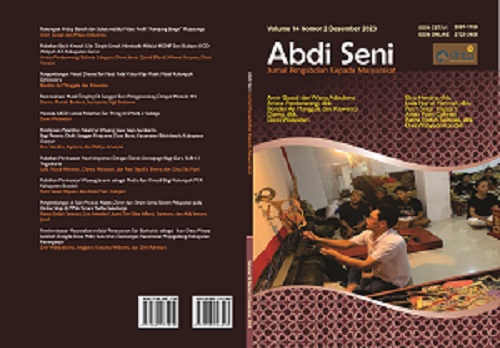PEMBERDAYAAN MASYARAKAT MELALUI PENYUSUNAN TARI BOTHOKLO SEBAGAI IKON DESA WISATA LEMBAH DUNGDE DESA MLILIR, KALURAHAN GENTUNGAN, KEC. MOJOGEDANG, KABUPATEN KARANGANYAR
Main Article Content
Abstract
Pemberdayaan Masyarakat Melalui Penyusunan Tari Bothoklo Sebagai Ikon Desa Wisata Lembah Dungde Desa Mlilir, Kalurahan Gentungan, Kec. Mojogedang, Kabupaten Karanganyar merupakan program pendampingan kepada masyarakat sebagai wujud nyata dari implementasi Visi Institut Seni Indonesia Surakarta. Penyusunan Tari Bothoklo sebagai ikon desa wisata, bersumber dari budaya tradisi masyarakat Desa Mlilir. Proses penyusunan dilakukan bersama masyarakat, hal ini sebagai bentuk edukasi cipta kreatif agar masyarakat terbangun jiwa krasinya. Metode yang digunakan dalam penyusunan tari Bothoklo adalah metode tiga R, yaitu Re- visiting, Re- Questioning dan Re- Interpreting. Hasil penyusunan Tari Botoklo kemudian dilatihkan kepada masyarakat sebagai sebagai penguatan daya tarik wisatawan. Pelaksanaan pelatihan dilaksanakan di Desa Wisata Lembah Dungde, Desa Mlilir, Kalurahan Gentungan. Hal ini dimaksudkan dapat lebih mendekatkan dan lebih mengenalkan kampus Institut Seni Indonesia Surakarta di masyarakat. Selain itu, bentuk pelatihan bersama masyarakat juga dapat sebagai daya tarik masyarakat / wisatawan yang datang di Lembah Dungde.
Hasil pemberdayaan masyarakat ini adalah tersusunnya Tari Bothoklo dengan mengangkat tema binatang mitologi Desa Mlilir, dikemas dalam bentuk tari kelompok Musik yang digunakan adalah ragam etnik di daerah Mlilir, sedangkan busana menggunakan artistik batang mendong dengan kemasan kini. Tari Bothoklo diajarkan kepada masyarakat Mlilir untuk dikembangkan sebagai ikon desa wisata.Downloads
Article Details
License and Copyright Agreement
In submitting the manuscript to the journal, the authors certify that:
- Their co-authors authorize them to enter into these arrangements.
- The work described has not been formally published before, except as an abstract or part of a published lecture, review, thesis, or overlay journal. Please also carefully read Abdi Seni's Posting Your Article Policy at https://jurnal.isi-ska.ac.id/index.php/abdiseni/about/editorialPolicies#peerReviewProcess
- That it is not under consideration for publication elsewhere,
- That its publication has been approved by all the author(s) and by the responsible authorities – tacitly or explicitly – of the institutes where the work has been carried out.
- They secure the right to reproduce any material already published or copyrighted elsewhere.
- They agree to the following license and copyright agreement.
Copyright
Authors who publish with Abdi Seni agree to the following terms:
- Authors retain copyright and grant the journal right of first publication with the work simultaneously licensed under a Creative Commons Attribution License (CC BY-SA 4.0) that allows others to share the work with an acknowledgment of the work's authorship and initial publication in this journal.
- Authors can enter into separate, additional contractual arrangements for the non-exclusive distribution of the journal's published version of the work (e.g., post it to an institutional repository or publish it in a book), with an acknowledgment of its initial publication in this journal.
- Authors are permitted and encouraged to post their work online (e.g., in institutional repositories or on their website) before and during the submission process, as it can lead to productive exchanges and earlier and greater citation of published work.
Licensing for Data Publication
Abdi Seni uses a variety of waivers and licenses that are specifically designed for and appropriate for the treatment of data:
- Open Data Commons Attribution License, http://www.opendatacommons.org/licenses/by/1.0/ (default)
- Creative Commons CC-Zero Waiver, http://creativecommons.org/publicdomain/zero/1.0/
- Open Data Commons Public Domain Dedication and Licence, http://www.opendatacommons.org/licenses/pddl/1-0/
Other data publishing licenses may be allowed as exceptions (subject to approval by the editor on a case-by-case basis). They should be justified with a written statement from the author, which will be published with the article.
Open Data and Software Publishing and Sharing
The journal strives to maximize the replicability of the research published in it. Authors are thus required to share all data, code, or protocols underlying the research reported in their articles. Exceptions are permitted but must be justified in a written public statement accompanying the article.
Datasets and software should be deposited and permanently archived in inappropriate, trusted, general, or domain-specific repositories (please consult http://service.re3data.org and/or software repositories such as GitHub, GitLab, Bioinformatics.org, or equivalent). The associated persistent identifiers (e.g., DOI or others) of the dataset(s) must be included in the article's data or software resources section. Reference(s) to datasets and software should also be included in the article's reference list with DOIs (where available). Where no domain-specific data repository exists, authors should deposit their datasets in a general repository such as ZENODO, Dryad, Dataverse, or others.
Small data may also be published as data files or packages supplementary to a research article. However, the authors should prefer a deposition in data repositories in all cases.
References
Afandi, Agus,dkk.,Modul Participatory Action Research (PAR) untuk Pengorganisasian Masyarakat (Community Organizing), Surabaya: LPPMUIN Sunan Ampel, 2015
Amir Piliang, Yasraf. Medan Kreatifitas, Memahami Dunia Gagasan. Yogyakarta. Cantrik Pustaka. 2018
Awang, San Afri, 1995. “Pemberdayaan Masyarakat dan Kelembagaan Lokal dalamProgram IDT: Studi Kasus Tipologi Desa Hutan di Kabupaten Madiun”. Dalam Mubyarto (ed.), Program IDT dan Pemberdayaan Masyarakat. Jakarta: Aditya Media.
Martono, Hendro. Koreografi Lingkungan, Revitalisasi Pemanggungan dan Gaya Penciptaan Seniman Nusantara. Yogyakarta. Cipta Media. 22012
Saputro, Thomas. 2014. Metode Pemberdayaan Masyarakat (PRA Dan RRA).
Sal Murgiyanto,Tradisi dan Inovasi: Beberapa Masalah Tari di Indonesia, Jakarta: Wedatama Widya Sastra, 2004.
Soedarsono, Pertunjukan dari Perspektif Politik, Sosial dan Ekonomi Yogyakarta : Gadjah Mada University Press, 2003.
Soedarsono. Seni Pertunjukan Indonesia & Pariwisata. Bandung, Masyarakat Seni Pertunjukan Indonesia (MSPI), 1999
Sumandiyo Hadi, Aspek-aspek Koreografi Kelompok, Yogyakarta, ISI Press.
……………….., Tari Kontemporer, Sebuah Fenomena Keakuan, Kekinian, Kedisinian. Surakarta, ISI Press. 2020
Supriyanto Eko. Ikat Kait Impulsif Sarira, Gagasan yang Mewujud Era 1990-2010. Yogyakarta, Garudhawaca, 2018.
Sri Rochana W, Press.2014 Dwi Wahyudiarto, , Pengantar Koreografi, Surakarta, STSI
